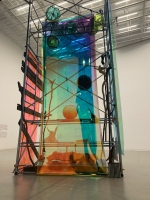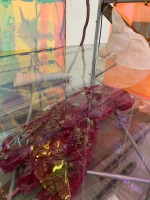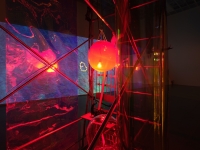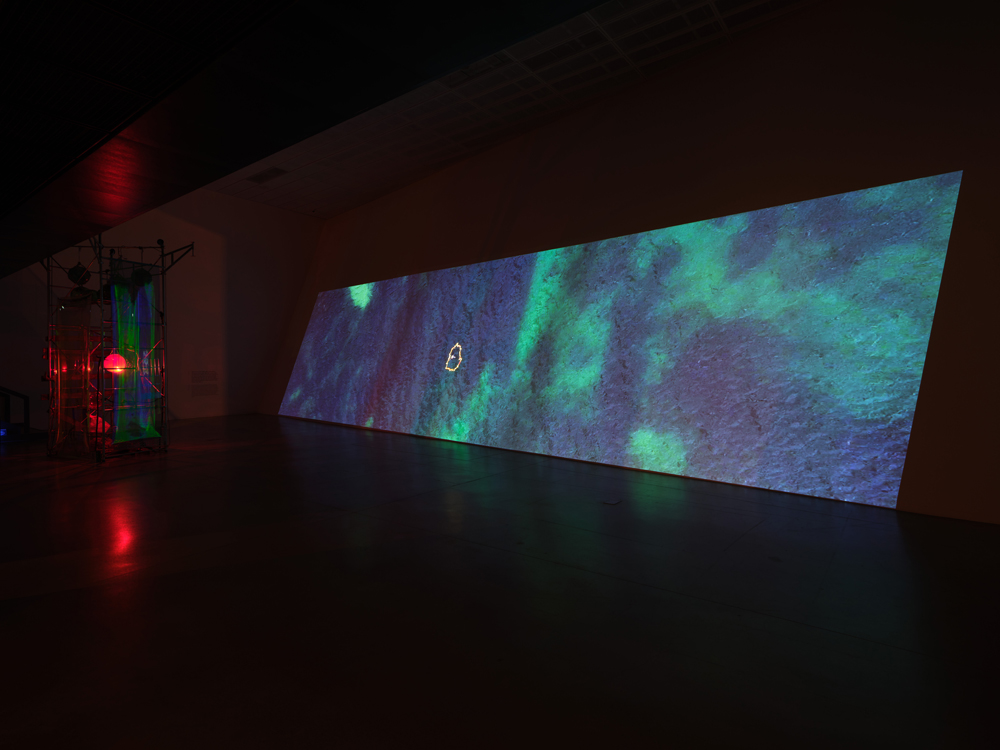
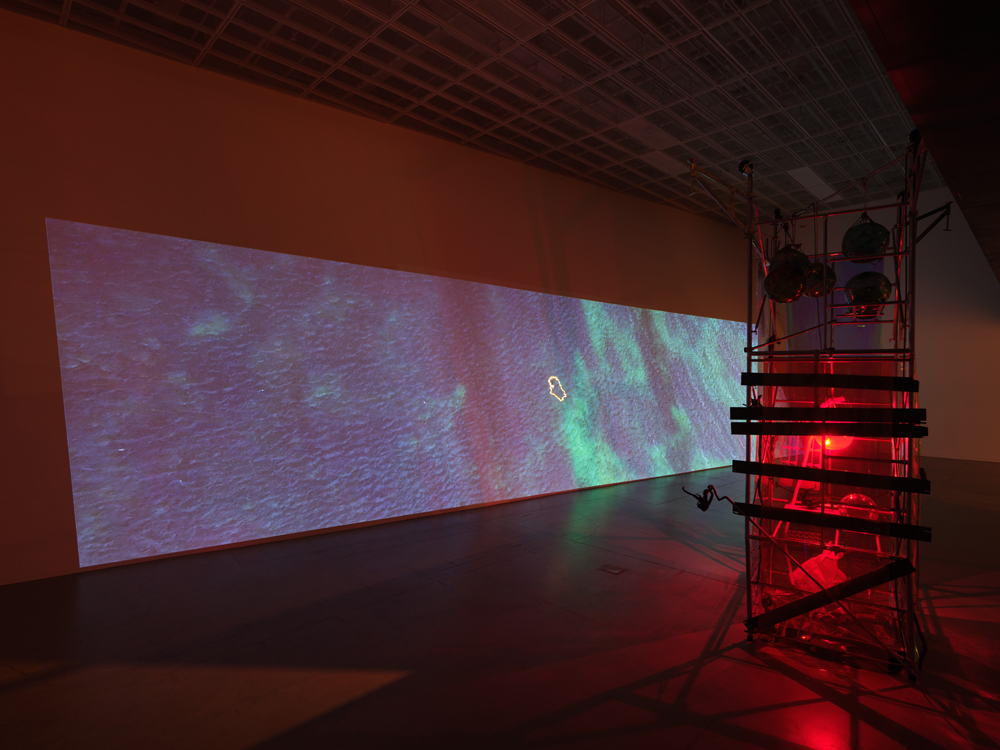
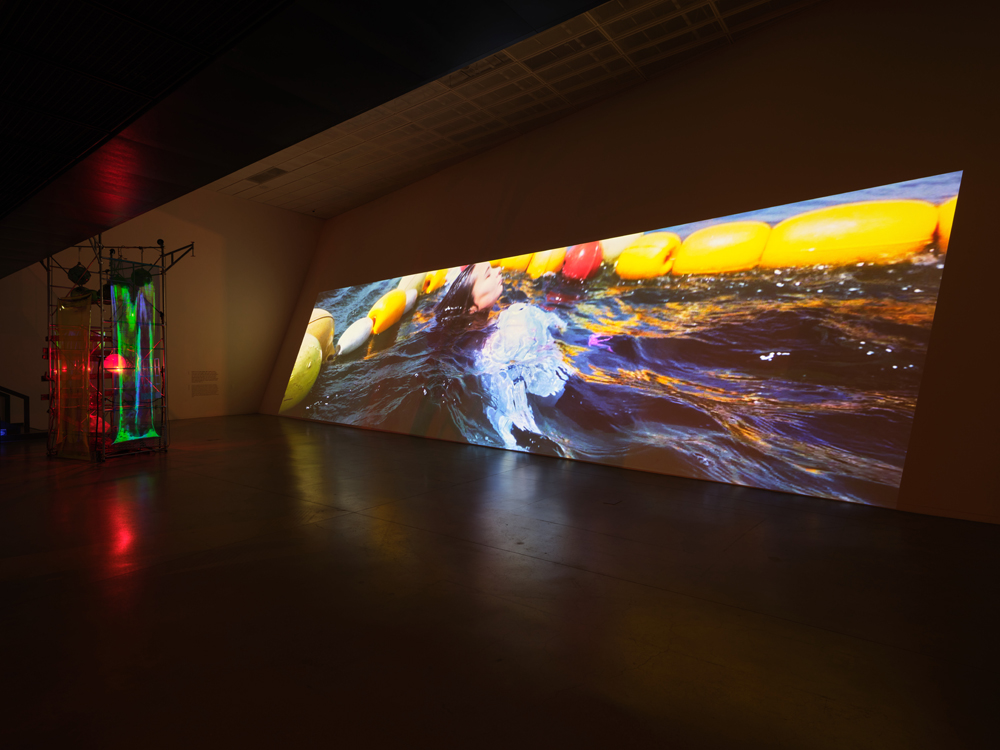
Portable keeper_Sea
2020
HD video and sound in loop, site specific installation
5min22sec
Suwon Museum of Arts
Seam
2020
Mixed media
Suwon Museum of Arts
Korean traditional costume, hemp cloth for dog, glass, buoy, canes, light bulb, holographic film, wood, artificial hair, debris, overturned scaffolding
The fifth anniversary exhibition of SUMA Born, a Woman installation view
<봉긋한 시간>, <솔기> 장소특정적 영상 설치 전경
수원시립미술관 개관 5주년 기념전 《내 나니 여자라,》
수원시립아이파크미술관
이 작품은 Portable Keeper- Sea라는 영어 제목으로 2018년 2월, 사진으로만 기록했던 미국 Captiva 작은 섬에서의 퍼포먼스를 <내 나니 여자라> 전을 위해 새롭게 제작한 무빙이미지 작품이다. <봉긋한 시간>이라는 한글제목은 작은 섬 파도 없는 밤바다를 관찰하며 생겨났다. 존재의 불안과 고독, 그리움과 기다림이 수면과 수심을 동시에 변화시키는 곳, 만물이 아무 설명도 없이 마치 투명한 행성을 감싸고 있는 고리에 포위되는 듯 침묵에 잠기는 때. 밤은 물 만큼이나 실체적이어서, 스며들거나 불어나고 무거워지면서 시간을 장악할 줄 안다. 이 세상의 모든 고통과 상처가 허물을 벗어나는 뱀처럼 후회 없는 심장의 박동으로 다시 태어나는 때. <봉긋한 시간>은 수평선과 지상의 시간이 일치해 부풀어 오르는 때를 가리킨다. 카메라의 시선은 그렇게 주문에서 풀려나 더 깊은 곳으로 혹은 더 높은 곳으로 데려가며 퍼지는 ‘이유없는 한 장면’의 요구를 그저 받아들이기로 한 듯, 계획적이지 않은 움직임을 보여준다.
소녀는 그 속에서 부표들 안에 갇혀 있고 그저 몸을 맡겨 물 위를 부유하는 듯 보이지만 스스로 부표의 경계선을 밀어내거나 이끌기도 하면서, 그냥 그렇게, 이해를 거부한 채, 그러나 고독하지 않은 고리를 만들어낸다.
이단지 큐레이터는 <봉긋한 시간>에 대해 다음과 같이 서술하고 있다.
“하늘과 바다, 전통과 현재, 할머니와 손녀, 기억과 미래, 삶과 죽음 사이, 물 위와 물 밑을 바느질하듯 이어 붙이는 카메라는 서로 같은 시공간을 살지 않았던 불-연속적인 세대를 다른 차원의 방식으로 공존하게 한다. 생전에 자기조직적 삶과 “스스로 생각하는 힘”을 가르쳐주신 작가의 외할머니는 바느질 보살로 불리우며 ‘고독하지 않은 홀로 되기’를 수행하는 존재와 같았다고 한다. 영상에서 흘러나오는 장영규의 낮은 종소리는 부처님이 계신 절의 처마 끝에 매달려 바람이 부는 대로 흔들리며 소리를 내는 붕어 모양의 풍경(風磬)을 떠올리게 한다. “물고기는 잠 잘 때도 눈을 감지 않는다”는 풍경의 의미는 언제나 깨어 있어 수행에 몰두하라는 불교적 가르침이다.(중략) 서로의 하울링을 이어받아 흩어져가는 소리는 이별 이후의 세계를 향한 수신자로, 또는 발신자로, 혹은 아무도 없는 집에서 시간마다 울기를 멈추지 않는 벽시계 속의 뻐꾸기처럼 속절없이 흩어지는 망각을 애도한다.”
전작에서 여러 차례 이별을 다루어 왔던 작가는 다시금 부재하는 기억과 기록, 가려진 존재들을 불러오고, 우리로 하여금 끝으로서의 이별이 아닌 새로운 시작과 만남으로서의 이별, 그 개방적 시간을 상상하게 한다.
The Fifth Anniversary Exhibition of SUMA
Born, A Woman
Suwon Museum of Art(SUMA) presents its fifth anniversary exhibition, Born, A Woman. This event aims to explore contemporary sentiments on the museum’s annual theme, ‘woman,’ through a key figure in Suwon’s local history – Hyegyeonggung Hong.
Since its inauguration in 2015, SUMA has been endeavoring to make meaningful inquiries into and reflections on the cultural and historical values of Suwon in the present context. Continuing to collect, research, and exhibit various findings on women’s narratives, the museum brings these efforts to culmination through this exhibition, illuminating intersecting threads of diachronic and synchronic perspectives on women in the tumultuous throes of gender politics throughout Suwon’s history.
The title Born, A Woman, gestures back to Hanjeungrok - an memoir written by the mother of Joseon Dynasty’s 22nd king Jeongjo and the bride of his father Sadoseja, Hyegyeonggung Hong. The sorrowful phrase ‘(I was) born (and it turned out to be that I was) a woman,’ utter by a women whose birth – expectantly awaited, having been preceded by an auspicious prenatal dream of a black dragon – was seen as a disappointment in Joseon’s androcentric society, is emblematic of women’s alienation and disadvantage at the time. The comma, meanwhile, aspires to new perspectives that seeks out the infinite potential and momentum of women in their fluid crossings of solid boundaries and institutionalized restrictions.
Born, A Woman, aims to examine how contemporary women understand themselves through and against such historical burdens to expand their roles and significance. We hope that by uncovering the numerous layers of femininity that are embedded in our daily encounters, the exhibition would serve as an opportunity for us to reinstate elided or fragmented narratives, and reawaken senses or moments we may have inadvertently elided. In doing so, we envision SUMA’s future role as a site of collaborative search and connection, whereat we may introduce and explore contemporary issues of women.
Text from the SUMA 's website
https://suma.suwon.go.kr/exhi/current_view.do?lang=en&ge_idx=1154#none
